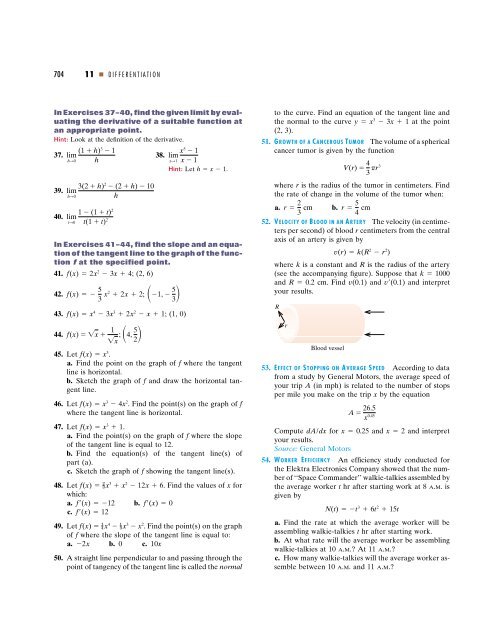11DIFFERENTIATION - Department of Mathematics
11DIFFERENTIATION - Department of Mathematics
11DIFFERENTIATION - Department of Mathematics
You also want an ePaper? Increase the reach of your titles
YUMPU automatically turns print PDFs into web optimized ePapers that Google loves.
704 11 DIFFERENTIATION<br />
In Exercises 37–40, find the given limit by evaluating<br />
the derivative <strong>of</strong> a suitable function at<br />
an appropriate point.<br />
Hint: Look at the definition <strong>of</strong> the derivative.<br />
(1 h)<br />
37. lim<br />
h0<br />
3 1<br />
h<br />
3(2 h)<br />
39. lim<br />
h0<br />
2 (2 h) 10<br />
h<br />
1 (1 t)<br />
40. lim<br />
t0<br />
2<br />
t(1 t) 2<br />
x<br />
38. lim<br />
x1<br />
5 1<br />
x 1<br />
Hint: Let h x 1.<br />
In Exercises 41–44, find the slope and an equation<br />
<strong>of</strong> the tangent line to the graph <strong>of</strong> the function<br />
f at the specified point.<br />
41. f(x) 2x2 3x 4; (2, 6)<br />
42. f(x) 5<br />
3 x2 2x 2;1, 5<br />
3<br />
43. f(x) x 4 3x 3 2x 2 x 1; (1, 0)<br />
2<br />
44. f(x) x 1 5<br />
;4,<br />
x<br />
45. Let f(x) x 3 .<br />
a. Find the point on the graph <strong>of</strong> f where the tangent<br />
line is horizontal.<br />
b. Sketch the graph <strong>of</strong> f and draw the horizontal tangent<br />
line.<br />
46. Let f(x) x 3 4x 2 . Find the point(s) on the graph <strong>of</strong> f<br />
where the tangent line is horizontal.<br />
47. Let f(x) x 3 1.<br />
a. Find the point(s) on the graph <strong>of</strong> f where the slope<br />
<strong>of</strong> the tangent line is equal to 12.<br />
b. Find the equation(s) <strong>of</strong> the tangent line(s) <strong>of</strong><br />
part (a).<br />
c. Sketch the graph <strong>of</strong> f showing the tangent line(s).<br />
48. Let f(x) x 3 x 2 12x 6. Find the values <strong>of</strong> x for<br />
which:<br />
a. f(x) 12 b. f(x) 0<br />
c. f(x) 12<br />
49. Let f(x) x 4 x 3 x 2 . Find the point(s) on the graph<br />
<strong>of</strong> f where the slope <strong>of</strong> the tangent line is equal to:<br />
a. 2x b. 0 c. 10x<br />
50. Astraight line perpendicular to and passing through the<br />
point <strong>of</strong> tangency <strong>of</strong> the tangent line is called the normal<br />
to the curve. Find an equation <strong>of</strong> the tangent line and<br />
the normal to the curve y x3 3x 1 at the point<br />
(2, 3).<br />
51. G ROWTH OF A C ANCEROUS T UMOR The volume <strong>of</strong> a spherical<br />
cancer tumor is given by the function<br />
V(r) 4<br />
3 r3<br />
where r is the radius <strong>of</strong> the tumor in centimeters. Find<br />
the rate <strong>of</strong> change in the volume <strong>of</strong> the tumor when:<br />
a. r 2<br />
5<br />
cm b. r <br />
3 4 cm<br />
52. V ELOCITY OF B LOOD IN AN A RTERY The velocity (in centimeters<br />
per second) <strong>of</strong> blood r centimeters from the central<br />
axis <strong>of</strong> an artery is given by<br />
v(r) k(R2 r2 )<br />
where k is a constant and R is the radius <strong>of</strong> the artery<br />
(see the accompanying figure). Suppose that k 1000<br />
and R 0.2 cm. Find v(0.1) and v(0.1) and interpret<br />
your results.<br />
R<br />
r<br />
Blood vessel<br />
53. E FFECT OF S TOPPING ON A VERAGE S PEED According to data<br />
from a study by General Motors, the average speed <strong>of</strong><br />
your trip A (in mph) is related to the number <strong>of</strong> stops<br />
per mile you make on the trip x by the equation<br />
A 26.5<br />
x0.45 Compute dA/dx for x 0.25 and x 2 and interpret<br />
your results.<br />
Source: General Motors<br />
54. W ORKER E FFICIENCY An efficiency study conducted for<br />
the Elektra Electronics Company showed that the number<br />
<strong>of</strong> ‘‘Space Commander’’ walkie-talkies assembled by<br />
the average worker t hr after starting work at 8 A.M. is<br />
given by<br />
N(t) t3 6t2 15t<br />
a. Find the rate at which the average worker will be<br />
assembling walkie-talkies t hr after starting work.<br />
b. At what rate will the average worker be assembling<br />
walkie-talkies at 10 A.M.? At 11 A.M.?<br />
c. How many walkie-talkies will the average worker assemble<br />
between 10 A.M. and 11 A.M.?

















